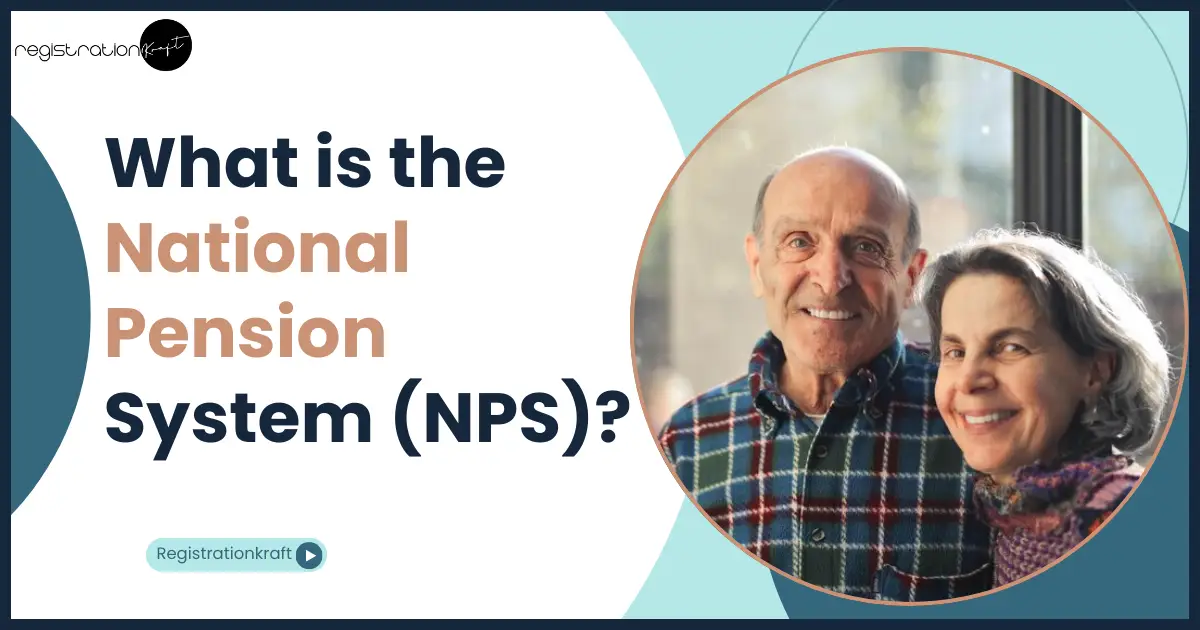What is the National Pension System (NPS) Scheme?

National Pension System (NPS) is an easily accessible, tax-efficient and flexible pension system open to all the citizens of India. Under this pension system, the individual contributes to their retirement account. The employer can also co-contribute for the social security of their employee.
NPS works on a Defined Contribution basis in which the subscriber contributes to their pension account. There is no fixed benefit that’d be provided at the time of exit from the pension system. The accumulated wealth basically depends on how much contribution was made and the income which was generated by investing such wealth. Greater contribution means that greater investments would be achieved. Accumulation of funds for a longer term would mean less charges would be deducted and the eventual benefit of the accumulated pension would be larger. To open up an NPS account, the person should be a citizen of India in the age group of 10-70.
NPS Corporate Model
Pension Fund Regulatory and Development Authority (PFRDA) has set up a separate model to provide NPS to the employees belonging to the corporate entities, Central Public Sector Enterprises and Public Sector Undertakings. This model is called “NPS – Corporate Sector Model”.
The following entities/organizations can join the NPS – Corporate Model
- Entities registered under Companies Act,
- Entities registered under various Co-operative Acts,
- Central Public Sector EnterprisesState Public SectorEnterprises
- Registered Partnership firm
- Registered Limited Liability Partnership (LLPs)
- Any body incorporated under any act of Parliament or State legislature or by order of Central/ State Govt
- Proprietorship concern
- Society/Trust.
NPS Asset Classes
- There are 4 asset classes during the National Pension System.
- Asset Class E: It invests in stocks or equities.
- Asset Class C: It invests in Corporate Bonds.
- Asset Class G: It invests in Government-issued Bonds.
- Asset Class A: It invests in alternative assets like Real Estate Investment Trusts and Infrastructure Investment Trusts.
| Class | Investment Asset |
| E | Equity/Stock |
| C | Corporate Bonds |
| G | Government Bonds |
| A | Alternative Assets like REITs & InVITs |
Investment Choice & Asset Allocation
The National Pension System allows the individuals to choose their own asset allocation by selecting Active Choice. As an alternate option, they can opt for Auto Choice wherein the investments are allocated across the asset class in a pre-defined manner and rebalanced annually.
Active Choice
In the case of Active Case, the subscriber gets to pick the desirable split of his NPS deposits between corporate bonds, government bonds, equities and assets at his own will. The subscriber shall provide Pension Fund Managers (PFMs) the percentage allocation to each of the asset classes in the following manner:
| Subscribers are required to decide the allocation pattern amongst these Asset Classes: E, C, G & A. |
| Asset Class | Cap on Investment |
| Equity (E) | 75% |
| Corporate Bonds (C) | 100% |
| Government Securities (G) | 100% |
| Alternate Investment Fund (A) | 5% |
Auto Choice
For the individuals who do not have the required knowledge for managing their NPS investment in a proper manner, NPS offers the facility of Auto Choice wherein the funds are allocated automatically across the asset classes in a predefined manner and rebalanced on yearly basis as per the subscriber’s age.
The following table below shows the asset allocation in each life-cycle fund:
| Aggressive | Moderate | Conservative | |||||||
| Age | E | C | G | E | C | G | E | C | G |
| Up to 35 years of age | 75% | 10% | 15% | 50% | 30% | 20% | 25% | 45% | 30% |
| 40 | 55% | 15% | 30% | 40% | 25% | 35% | 20% | 35% | 45% |
| 45 | 35% | 20% | 45% | 30% | 20% | 50% | 15% | 25% | 60% |
| 50 | 20% | 20% | 60% | 20% | 15% | 65% | 10% | 15% | 75% |
| 55 | 15% | 10% | 75% | 10% | 10% | 80% | 5% | 5% | 90% |
NPS Returns
There is no fixed interest rate under the National Pension System. The returns are linked to the market. Through various pension fund managers, the contributions in the NPS account can be invested in up to the 4 asset classes. The national pension scheme is a defined, voluntary contribution pension in which the subscribers make contributions which accumulate till retirement and the entire corpus witnesses growth through the market-linked returns. The whole pension withdrawal amount is tax-free.
NPS Accounts’ Types
There are two types of NPS accounts viz. Tier 1 Account and Tier 2 Account.
Tier 1 Account: It is a mandatory retirement account in which before reaching maturity, only withdrawal up to 25 percent of investment is allowed. On reaching maturity, 60 percent of the corpus can be withdrawn. From the remaining 40 percent corpus, the account holder is required to buy an annuity. In case of a corpus being less than Rs 5 Lakh, the account holder can withdraw the entire corpus. Only 20 percent is given as lump sum and the remaining 80 percent is used to buy an annuity in case of pre-closure of the account. Presently, there is no tax applicable on the withdrawal from NPS as per the announcement made in the Union Budget of the year 2019. Due to this, NPS is at par with other popular saving schemes in the country such as PPF and Employement Provident Fund (EPF) when it comes to tax treatment.
Tier 2 Account: The Tier 2 Account is a voluntary retirement-cum-investment account which requires the Tier 1 Account to be active. In case of a Tier 2 Account, it is up to the subscribers when they want to invest or withdraw their funds based on their convenience. There are no tax deductions for private sector employees or self employed persons under this account.
Tax Treatment
Tax Benefits on Investment: On an investment up to Rs 1.5 Lakh under section 80C of the Income Tax Act, 1961, the NPS subscribers can claim tax benefits. As per the same section, the deduction comes under the overall upper limit of Rs 1.5 lakhs. Under the section 80CCD (1b), the NPS investors are eligible to claim additional exclusive tax benefits on investments which are up to Rs 50,000 over and above the Rs 1.5 Lakh limit. Over and above the investment limit of Rs 1.5 Lakh under section 80C, and the limit of Rs. 50,000 under section 80CCD (1b), tax benefits can be claimed by the subscribers on the contributions from the employer up to 10% of the basic salary of the employee under section 80CCD (2). This deduction is only meant for employees earning up to Rs. 7.5 Lakh.]
Tax Benefits on the Returns: As discussed earlier, NPS returns are linked to the market. The better the market performs, the better the returns are. Returns earned in Tier 1 investments are eligible for tax exemption.
Tax Benefits on Maturity Period: The NPS account reaches the maturity at the age of 60. It is important to note that only 60 percent of the accumulated corpus can be withdrawn at the maturity time. The remaining 40 percent of the corpus should be invested in annuity (as this is mandatory).
NPS Partial Withdrawal
The Pension Fund Regulatory Authority of India (PFRDA) is responsible for the regulation and administration of NPS. For NPS, the superannuation age is 60 and the individuals can avail the benefits till they reach 75 years of age. For specific goals/issues like home buying, child’s education or serious health problems, partial withdrawals of up to 25% of the contributions can be made from NPS after 3 years of the account opening. Partial withdrawals can only be done 3 times in the entire life cycle. After the first withdrawal, there is no ‘waiting period’ for executing the second or third partial withdrawal; however, this condition applies only to the incremental investment.
The subscribers can opt for partial withdrawals in the following cases:
- Higher education of children
- Marriage of children
- For the construction or purchase of a flat or residential house either in your own name or joint ownership with your spouse. However, this will not be permitted if you already own or jointly own a house or flat other than ancestral property.
- For the treatment of any of the illnesses mentioned below. The patient can be the subscriber, his spouse, children or dependent parents.
- Cancer
- Kidney Failure
- Preliminary Pulmonary Arterial Hypertension
- Multiple Sclerosis
- Major Organ Transplant
- Coronary Artery Bypass Graft
- Aorta Graft Surgery
- Heart Valve Surgery
- Stroke
- Myocardial Infarction a.k.a Heart Attack
- Coma
- Total Blindness
- Paralysis
- Accident of serious/life-threatening nature
- Any other critical illness having a life-threatening nature (the same is specified by the PFRDA from time to time)
Conclusion
NPS is a beneficial scheme for investment. Under NPS, the investments are made into equities which can offer higher returns as compared to other tax-saving investment schemes such as Public Provident Fund (PPF). NPS works on a Defined Contribution basis in which the subscriber contributes to their pension account. There is no fixed benefit that’d be provided at the time of exit from the pension system. The accumulated wealth basically depends on how much contribution was made and the income which was generated by investing such wealth. Greater contribution means that greater investments would be achieved. NPS has delivered 8-10 percent annualized returns so far. The tax saving benefits of NPS is one of the main reasons why an individual should consider investing in it. Since it is a pension scheme, an individual needs to keep making contributions until the age of 60 years (when the scheme reaches the maturity). However, in special cases the subscribers are permitted for partial withdrawal up to 25 percent after the completion of at least 3 years of continuous contribution to the fund.
Frequently Asked Questions (FAQs)
Q1. How are the funds contributed by the subscribers managed under NPS?
A. The funds which the Subscribers contribute are invested by the PFRDA registered Pension Fund (PFs). These PFs are responsible for managing the subscriber funds based on the subscriber’s preference. At present, there are 10 pension funds:
- Birla Sun Life Pension Fund Ltd.
- HDFC Pension Management Co. Ltd.
- ICICI Prudential Pension Fund Management Ltd.
- Kotak Mahindra Pension Funds Ltd.
- LIC Pension Fund Ltd.
- SBI Pension Fund Pvt. Ltd.
- UTI Retirement Solutions Ltd.
- Axis Pension Fund
- Max life Pension Fund Management
It is important to note that this list may undergo changes if the new pension fund managers are registered by PFRDA or in case existing ones are deregistered.
Q2. How many asset classes are there in the National Pension System?
A. There are 4 asset classes during the National Pension System: (i) Asset Class E: It invests in stocks or equities. (ii) Asset Class C: It invests in Corporate Bonds. (iii) Asset Class G: It invests in Government-issued Bonds. (iv) Asset Class A: It invests in alternative assets like Real Estate Investment Trusts and Infrastructure Investment Trusts.
Q3. Are NRIs and OCIs allowed to open an NPS Account?
A. Yes, both NRI and OCI can open NPS accounts.
Q4. Can the subscriber exit the NPS before reaching the age of 60?
A. There is a lock-in period of 5 years under the National Pension System which is calculated from the date of account opening. If the subscriber wants to withdraw from the scheme before reaching the age of 60, they can opt for premature exit. However, it is mandatory to use 80 percent of their corpus to buy an annuity and can only withdraw 20 percent which is exempted from tax. An annuity refers to the fixed payment which you can receive for the rest of your life. It can be taken on a monthly basis and serves as a monthly pension.
Categories: Gov Yojana






Good read! Very detailed article.